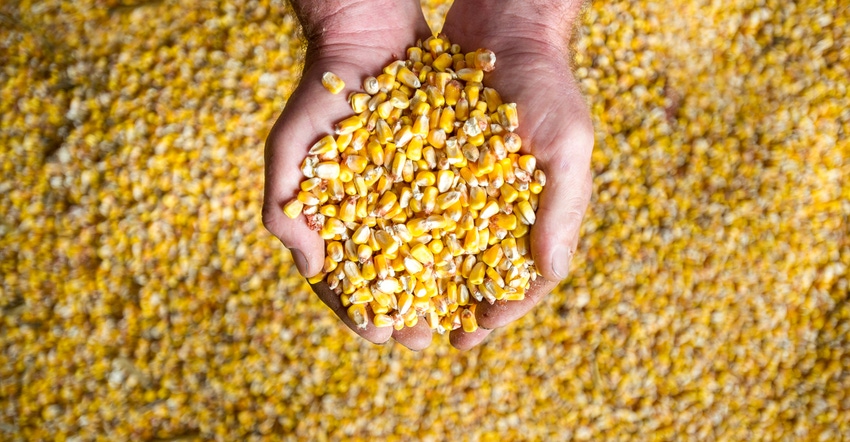September 3, 2021

Many corn producers are eager to estimate yield potential due to the extreme drought experienced over much of the state this year. The most commonly used method to estimate corn grain yield in the field is the Yield Component Method, developed many years ago at the University of Illinois. The Yield Component Method can be used well in advance of harvest, as early as the milk stage (R3) of kernel development. Estimates made earlier than R3 risk being overly optimistic if later stresses cause kernel abortion or ear loss.
This method is based on the premise that yield can be estimated from the components that constitute grain yield, including ear number, number of kernel rows and kernels per row. The final factor, weight per kernel, cannot be measured until maturity (black layer) and, even then, depends on grain moisture at harvest. So, the kernel weight used is somewhat of a “fudge factor” and can be adjusted based on the level of stress the crop endured during the growing season.
Crop uniformity also greatly influences the accuracy of any yield estimation technique. The less uniform the field, the greater the number of samples that should be taken to estimate yield. Attempt to sample locations within the field randomly so as to not bias the yield estimate up or down. In a fairly uniform field, calculate yield at five different locations. Follow these steps:
1. Measure row. At each location, measure off a length of row equal to 1/1,000th of an acre. For 30-inch rows (2.5 feet), this is 17 feet, 5 inches. For 36-inch rows, this is 14 feet, 6 inches. For other row spacings, divide 43,560 by the row spacing in feet and then divide that result by 1,000.
2. Count harvestable ears. Count and record the number of harvestable ears on the plants in 1/1,000th acre of row. Do not count dropped ears or ears on severely lodged plants unless you are confident that the combine header will be able to pick them up.
3. Count kernel rows. For every fifth ear in the sample row, count the number of complete kernel rows per ear. Do not sample nubbins or obviously deformed ears unless they are representative of the sampled area. If row number changes from butt to tip, which can happen due to drought stress, estimate an average kernel row number per ear. Don’t count the butt or tip ends, but rather choose an area in the middle of the cob where there is a complete ring of kernels. Do not count aborted kernels. Kernel row number is almost always even, but extreme drought or nutrient stress may result in an odd number.
4. Estimate kernels per row. Using the same ears, determine the average number of kernels per row on each ear. This is done by counting the kernels along the length of the cob from butt to tip. If numbers of kernels per row are not equal among the rows of an ear, estimate a value for the ear.
5. Determine yield. Estimate the yield for each location by multiplying the ear number by the average kernel row number by the average kernels per row, and then divide by 90. The “fudge factor” of 90 represents 90,000 kernels per 56-pound bushel. In growing seasons with stressful conditions, kernel size will likely be smaller than average and so a higher number, such as 100, can be used. In a year with excellent grain fill conditions and little stress, a lower number, say 75, can be used, representing larger kernels. So, the equation looks like this:
For example, say you counted 24 harvestable ears at the first location. Sampling every fifth ear resulted in an average kernel row number of 16 and an average number of kernels per row of 30. The estimated yield for this location would be: (24×16×30) / 90 = 128 bushels per acre
Now, let’s say this field encountered moisture stress during pollination and silking. Using a higher denominator, that is, smaller kernel size or lighter kernel weight, would be appropriate. So, using the same numbers as before, but a higher number of kernels per bushel, means: (24×16×30) / 100 = 115 bushels per acre
Repeat these steps at as many sites within a field as you deem representative. Calculate the average yield for all sites to estimate the yield for the field.
Remember that this method for estimating corn grain yield is indeed only an estimate. Since kernel size and weight will vary depending on hybrid and environment, this method should only be used to determine ballpark grain yields.
Yield will likely be overestimated in a year with poor conditions during grain fill (such as the current drought) and underestimated in a year with excellent conditions throughout grain fill. The Yield Component Method for estimating corn grain yield tends to be accurate within ±20 bushels per acre. Use the yield estimates obtained by this method for general planning purposes only.
Source: North Dakota State University Extension is solely responsible for the information provided and is wholly owned by the source. Informa Business Media and all its subsidiaries are not responsible for any of the content contained in this information asset.
You May Also Like




